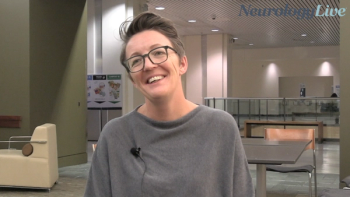
Pediatric MS Disease Activity May Increase Upon Menarche
Findings from a study of more than 500 girls with multiple sclerosis suggest that first menstruation and the onset of puberty may be a time of increased disease activity in pediatric MS.
Kristen M. Krysko, MD
A new dataset from a study to evaluate the association between the disease course in pediatric multiple sclerosis (MS) and first occurrence of menstruation, or menarche, suggests that the onset of puberty may be a time of increased disease activity. This finding implies that menarche may be a time to consider an alteration in therapeutic approach.1
Data from an adjusted negative binomial analysis showed that annual relapse rates (ARRs) during the period prior to menarche (premenarche) was 0.43 and during the period after menarche (postmenarche) was 0.36, compared to the 0.50 rate in the perimenarche period (P = .16).
The authors, including Kristen M. Krysko, MD, clinical fellow in neurology, UCSF Weill Institute for Neurosciences, and colleagues, conducted the research with a cohort of 503 girls with MS , with a mean age of onset of 13 years—on average, 2.5 years after menarche. They compared relapse rates across the premenarche, perimenarche, and postmenarche periods. The data were included for presentation at the
When conducting an adjusted repeated-events Cox regression analysis, Krysko and colleagues noted an increased hazard to relapse with stage of development from the premenarche period (hazard ratio [HR], 0.60; 95% CI, 0.45—0.79) through the perimenarche period (HR, 0.79; 95% CI, 0.62–1.02) compared to the postmenarche period (P = .0006).
CMSC 2020:
Of the 503 girls included, onset of MS was during premenarche in 53, perimenarche in 84 (defined as within ±1 year of menarche), and postmenarche in 366. “Before menarche, girls have lower relapse rates. Onset of puberty may be a time of increase in disease activity and may require consideration of a change in therapeutic approach,” Krysko and colleagues concluded.
The analysis was retrospective in nature, and the cohort was prospectively followed. The girls with MS included met MS criteria within the US Network of Pediatric MS Centers database. Only those with known menarche dates were included in the analysis, and with relapses collected prospectively. Both negative binomial and repeated Cox regression models were used to assessments were adjusted for the tier of disease-modifying therapy (DMT) and body mass index (BMI).
This analysis is likely a welcomed one, as the amount of literature in pediatric MS is limited, according to Brenda Banwell, MD, chief, Division of Neurology, Children’s Hospital of Philadelphia. This week at CMSC 2020, Banwell delivered a presentation on the current perspectives on the state of care and research in pediatric MS, noting that over time, the discussions in MS have truly begun to take shape for the pediatric MS population. Long believed to have a different disease altogether, pediatric MS has since been accepted to be the same disease as observed in adults.2
Although, the aforementioned long-lasting lack of understanding led to a rather sizable gap in research for this population, which Banwell discussed with NeurologyLive leading up to her presentation. “The single most pressing issue for the treatment of children with MS is to have proper clinical trial evidence for efficacy and clinical trial and extension phase data for safety,” she explained.
Watch her share her insight below.
For more coverage of CMSC 2020,
REFERENCES
1. Krysko KM, Waltz M, Chitnis T, et al. Menarche and Relapses in Girls with Pediatric Multiple Sclerosis. Int J MS Care. 2020;22(2 Suppl): DAM02.
2. Banwell B. Current Perspectives of Pediatric Care and Research. Presented at: CMSC 2020; May 26-29, 2020.
Newsletter
Keep your finger on the pulse of neurology—subscribe to NeurologyLive for expert interviews, new data, and breakthrough treatment updates.



































